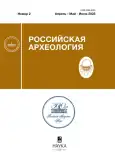Mass modeling of small-sized archaeological objects: the case of Roman-period fishing gear
- Authors: Olkhovsky S.V.1, Svoysky Y.M.2,3, Romanenko E.V.3, Girich A.P.1,2,3, Biryukova E.R.1,3,4
-
Affiliations:
- Centre for Underwater Archaeological Heritage at the Institute of Archaeology of the RAS
- Higher School of Economics
- RSSDA Laboratory
- Moscow Architectural Institute
- Issue: No 2 (2025)
- Pages: 67-81
- Section: ARTICLES
- URL: https://rjsvd.com/0869-6063/article/view/687968
- DOI: https://doi.org/10.31857/S0869606325020056
- EDN: https://elibrary.ru/IQADEB
- ID: 687968
Cite item
Abstract
The article considers the problems of documenting small-sized finds using the case of a large series of fishing gear items found during underwater excavations of a Roman-period pier in Phanagoria. The proposed methodology («revolver documentation method») includes automated 3D modeling of frequent archaeological finds using a photogrammetric method and algorithmization of procedures for processing the collected data. The methodology ensures high detail and accuracy of modeling, which allows using models for automated collection of morphometric data, constructing precise drawings and creating raster renders, which together give a complete idea of the geometry of the objects under study. The models and the results of their visualization are adapted for web-presentation, which gives researchers the opportunity to study objects remotely.
Keywords
Full Text
About the authors
S. V. Olkhovsky
Centre for Underwater Archaeological Heritage at the Institute of Archaeology of the RAS
Author for correspondence.
Email: uwiaran@gmail.com
Russian Federation, Moscow
Yu. M. Svoysky
Higher School of Economics; RSSDA Laboratory
Email: rutil28@gmail.com
Russian Federation, Moscow; Moscow
Ekaterina V. Romanenko
RSSDA Laboratory
Email: eromanenko@yandex.ru
Russian Federation, Moscow
A. P. Girich
Centre for Underwater Archaeological Heritage at the Institute of Archaeology of the RAS; Higher School of Economics; RSSDA Laboratory
Email: girichap20@gmail.com
Russian Federation, Moscow; Moscow; Moscow
E. R. Biryukova
Centre for Underwater Archaeological Heritage at the Institute of Archaeology of the RAS; RSSDA Laboratory; Moscow Architectural Institute
Email: 906kater@gmail.com
Russian Federation, Moscow; Moscow; Moscow
References
- Casasola D.B., 2010. Fishing Tackle in Hispania: Reflections, Proposals and First Results. Ancient nets and fishing gear: Proceedings of the international workshop on «Nets and fishing gear in classical antiquity: a first approach». Cadiz, pp. 83–137.
- Gaydukevich V.F., 1952. On the weaving in Bosporan settlements. Bosporskie goroda [Bosporan cities], 1. Itogi arkheologicheskikh issledovaniy Tiritaki i Mirmekiya v 1935–1940 gg. [Results of archaeological research in Tyritake and Myrmekion in 1935–1940]. Moscow: Izdatel'stvo Akademii nauk SSSR, pp. 395–414. (Materialy i issledovaniya po arkheologii SSSR, 25). (In Russ.)
- Göttlich F., Schmitt A., Kilian A. et al., 2021. A new method for the large-scale documentation of pottery sherds through simultaneous multiple 3D model capture using structure from motion: Phoenician carinated-shoulder amphorae from tell El-Burak (Lebanon) as a case study. Open Archaeology, vol. 7, no. 1, pp. 256–272.
- Kulikov A.V., 1998. Materials for the study of ancient marine fishing industries. Drevnosti Bospora [Antiquities of the Bosporus], 1. Moscow: Institut arkheologii Rossiyskoy akademii nauk, pp. 186–201. (In Russ.)
- Kulikov A.V., 2005. Archaeological evidence of fishing at the classical fortified settlement of Akra. Bosporskie issledovaniya [Bosporus studies], 9. Simferopol'; Kerch', pp. 251–270. (In Russ.)
- Kuznetsov V.D., Ol'khovskiy S.V., 2016. Some results of underwater research in Phanagoria (1998–2015). Materialy po arkheologii i istorii Fanagorii [Materials on the archaeology and history of Phanagoria], 2. Moscow: Institut arkheologii Rossiyskoy akademii nauk, pp. 325–352. (Fanagoriya. Rezul'taty arkheologicheskikh issledovaniy, 4). (In Russ.)
- Matera M., 2017. Fishing industry of Tanais. The role and place of fishing in the economic life and economy of the population of Tanais. Krym i Severnoe Prichernomor'e v arkheologicheskikh issledovaniyakh 1956–2013 gg. [Crimea and the Northern Pontic in archaeological research of 1956–2013]. Varshava: Institute of Archaeology, University of Warsaw, pp. 165–180. (In Russ.)
- Onayko N.A., 1956. On Phanagorian fishing sinkers. Fanagoriya [Phanagoria]. Moscow: Izdatel'stvo Akademii nauk SSSR, pp. 154–160. (Materialy i issledovaniya po arkheologii SSSR, 57). (In Russ.)
- Romero A.M.S., Vicente A.M., 2016. Los orígenes de las conservas piscícolas en el estrecho de Gibraltar en época fenicio-púnica. Un Estrecho de Conservas. Cádiz: Universidad de Cádiz, pp. 23–41.
- Rummel M., 2024. Pottery from motion – a refined approach to the large-scale documentation of pottery using structure from motion. Open Archaeology, vol. 10, no. 1, pp. 1–23.
- Sapirstein P., Murray S., 2017. Establishing Best Practices for Photogrammetric Recording During Archaeological Fieldwork. Journal of Field Archaeology, vol. 42, no. 4, pp. 337–350.
- Svoyskiy Yu.M., Zaytsev A.V., Stoyanov R.V., report. On a new method for photogrammetric recording of frequent ceramic finds. Slovo i artefakt: mezhdistsiplinarnye podkhody k izucheniyu antichnoy istorii: materialy VII Vserossiyskoy konferentsii (Saratov, 14–17 oktyabrya 2021 g.) [Word and artifact: interdisciplinary approaches to the study of classical period: Proceedings of the VII All-Russian conference (Saratov, October 14–17, 2021)]. (In Russ.)
- Zaytsev A.V., report. Digital documentation of frequent finds. Materialy kruglogo stola «Sovremennye problemy izucheniya drevney keramiki» (Moskva, Institut arkheologii Rossiyskoy akademii nauk, 27 oktyabrya 2023 g.) [Proceedings of the round table «Modern problems of studying ancient ceramics» (Moscow, Institute of Archaeology RAS, October 27, 2023)]. (In Russ.)
- Zaytsev A.V., Romanenko E.V., Svoyskiy Yu.M., 2023. On robotization and algorithmization in documenting frequent archaeological finds. Arkheologiya i geoinformatika: Shestaya mezhdunarodnaya konferentsiya (Moskva, Institut arkheologii Rossiyskoy akademii nauk, 24–26 maya 2023 g.): tezisy dokladov [Archaeology and geoinformatics: Sixth International conference (Moscow, Institute of Archaeology RAS, May 24–26, 2023): Abstracts of papers]. Moscow: Institut arkheologii Rossiyskoy akademii nauk, pp. 38, 39. (In Russ.)
- Zaytsev A.V., Svoyskiy Yu.M., Romanenko E.V., Ivanova A.V., report. Problema publikatsii massovoy keramiki i tsifrovye metody ee resheniya. Revol'vernoe dokumentirovanie i vektornoe profilirovanie: doklad na VI (XXII) Vserossiyskom arkheologicheskom s’ezde (Samara, 5–9 iyunya 2022 g.) [The problem of publishing frequent ceramic finds and digital methods for solving it. Revolver documentation and vector profiling: report at the VI (XXII) All-Russian archaeological congress (Samara, June 5–9, 2022)]. (In Russ.)
Supplementary files


















